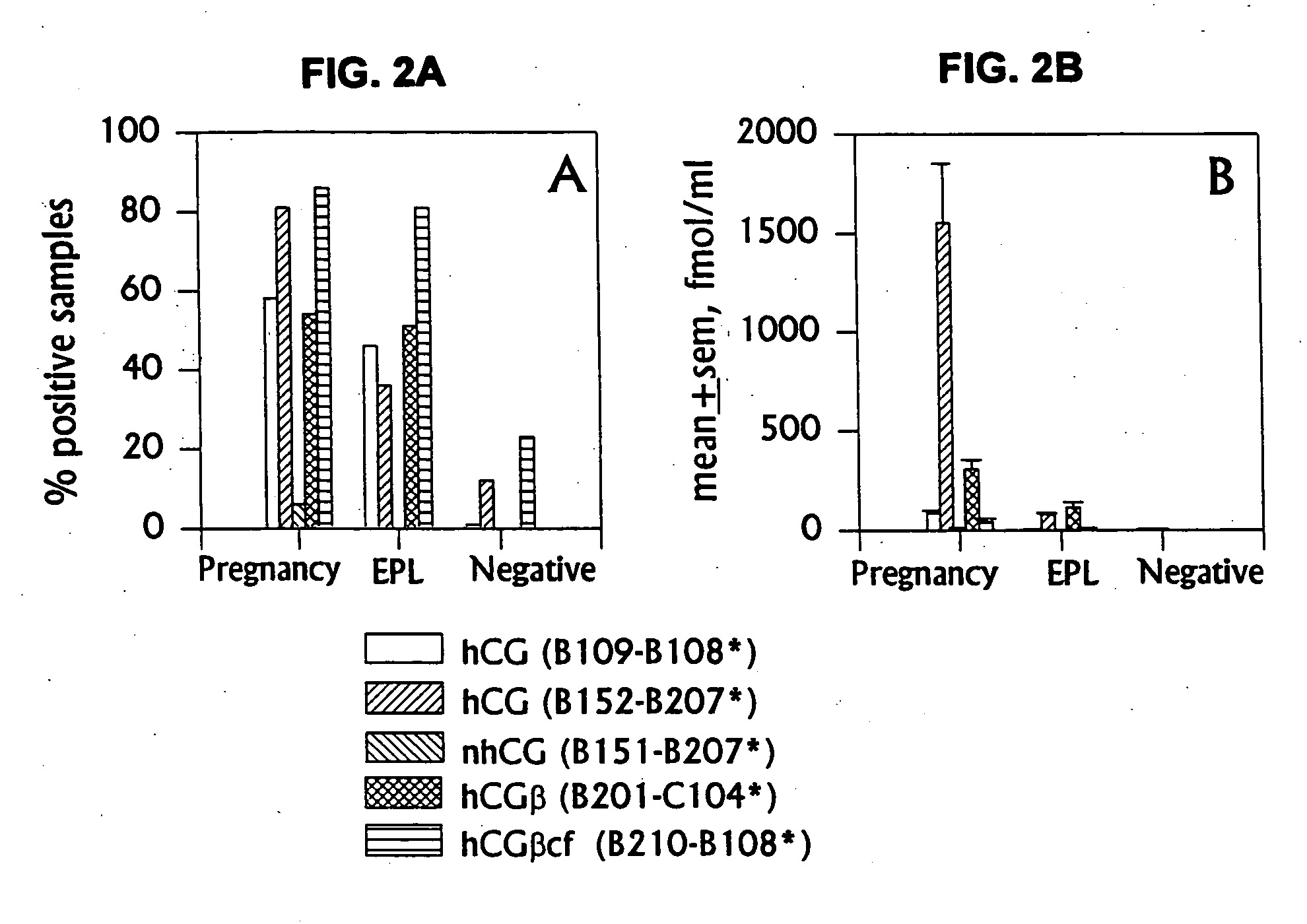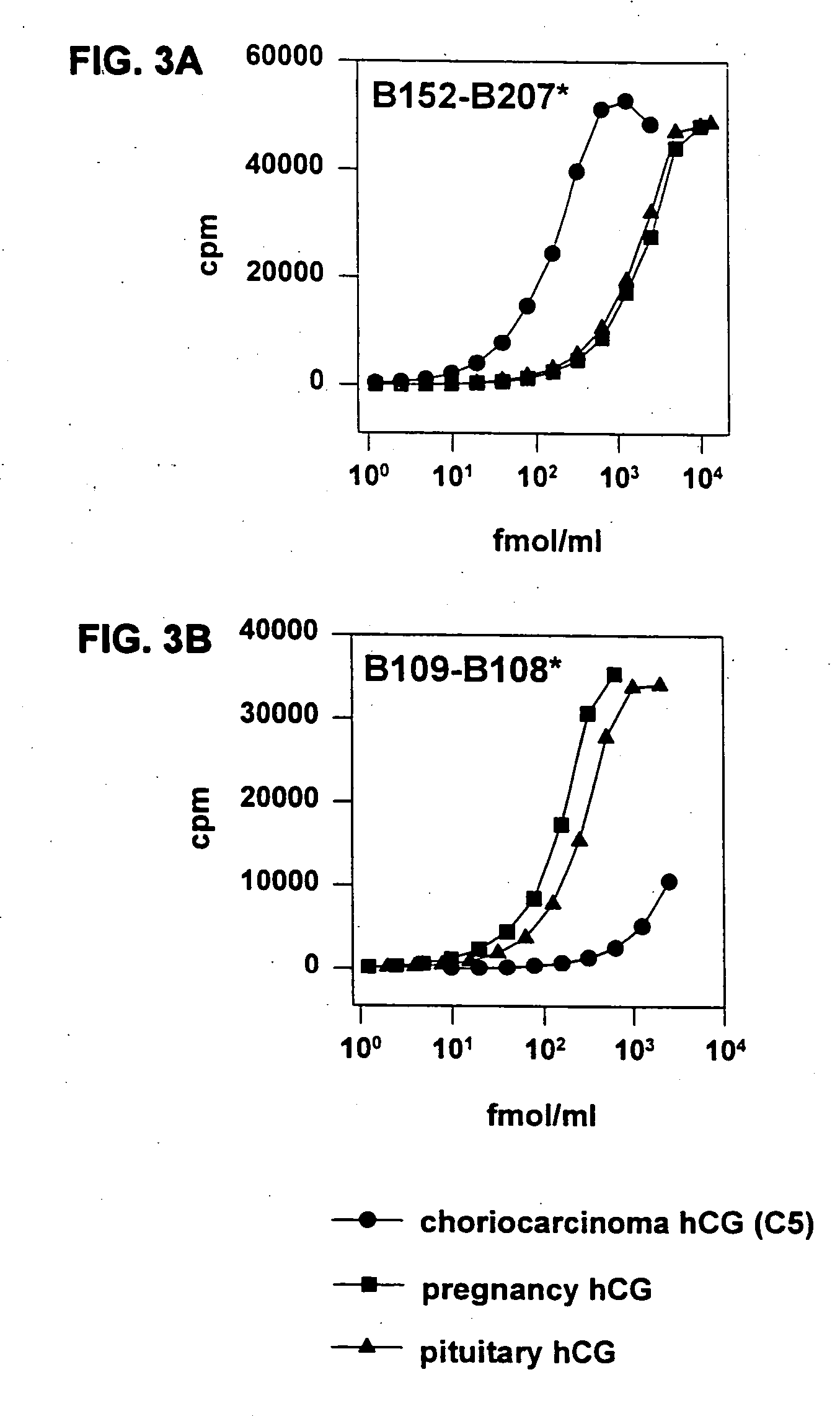Methods for predicting pregnancy outcome in a subject by hCG assay
a technology of hcg assay and subject, which is applied in the field of methods for predicting pregnancy outcome in a subject by hcg assay, can solve the problems of loss, inadequate hormonal potency, and widespread early pregnancy loss (epl)
- Summary
- Abstract
- Description
- Claims
- Application Information
AI Technical Summary
Benefits of technology
Problems solved by technology
Method used
Image
Examples
example 1
Antibodies to and Analysis of Molecular Isoforms of hCG in Early Pregnancy and Early Pregnancy Loss
Introduction
[0073] Almost all investigations of the incidence of early pregnancy loss (EPL), either in normal populations or in populations at risk as a consequence of exposure to putative reproductive toxins (Hakim, R. B., et al., 1995; Lasley, B. L., et al., 1995) use assays for heterodimeric, non-nicked hCG or combination assays which include free beta subunit and beta core fragment of hCG. One concern about the forms of hCG to include in the measurement in EPL was heightened with respect to the nicking phenomenon described above. Because nicked hCG molecules are not measured bv the antibodies employed in most EPL studies, the incidence of EPL is presumably underestimated by an amount proportional to the extent of nicking in the urinary molecule. Another concern of significant importance was a determination of the nature of the “hCG like” immunoreactivity in the urine in the perio...
example 2
B152 / B109 Ratio Predicts Pregnancy Outcome
The B152 / B109 Ratio Measured In Urine Samples Throughout The Pregnancy
[0088] The relative concentrations of hCG isoforms in 103 normal pregnancy urine samples (5-39 weeks post last menstrual period—LMP) were determined by two immunometric assays (Bl52-B207* and B109-B108*). Both because of the wide range of hCG concentrations in different samples, even at the same gestational age, and because neither of the assays is totally specific for the two (or more) families of hCG isoforms present, we find that presenting the data as a ratio of the observed two isoform groups more clearly delineates the change in isoform content as pregnancy progresses. This calculated ratio is shown in FIG. 4. In weeks 5-8 of pregnancy, the ratio of B152 / B109 isoforms ranged between 6.2 and 1.3, indicating a predominance of the B152 isoform(s) in early pregnancy. During the 10 to 12 week period, the ratio ranged from 1-0.2, indicating that an inversion in hCG isofo...
example 3
B152 And B151 Immunoreactivity In Non-Trophoblastic Malignancy
[0111] With the exception of trophoblastic disease and testicular cancer, hCG is expressed in the blood of about 20% of patients with all other types of cancer(Hussa, R. O., 1987). HCG beta core fragment in the urine has a significantly higher level of expression, especially in gynecological malignancy. Since the B152 antibody was developed to a form of hCG produced in a malignancy, it was of interest to examine the expression of B152 and nicked hCG immunoreactivity (B151) in non-trophoblastic malignancy. Accordingly, blood and urine derived. from men undergoing chemotherapy for prostate cancer or women for ovarian cancer were evaluated for the expression of hCG isoforms in plasma and urine. It is significant that in prostate cancer, B152 hCG immunoreactivity is found in the blood and urine of prostate cancer patients in instances when there is no hCG detected by B109-Bl08*. In ovarian cancer patients evaluated, there is...
PUM
| Property | Measurement | Unit |
|---|---|---|
| pH | aaaaa | aaaaa |
| temperature | aaaaa | aaaaa |
| pH | aaaaa | aaaaa |
Abstract
Description
Claims
Application Information
 Login to View More
Login to View More - R&D
- Intellectual Property
- Life Sciences
- Materials
- Tech Scout
- Unparalleled Data Quality
- Higher Quality Content
- 60% Fewer Hallucinations
Browse by: Latest US Patents, China's latest patents, Technical Efficacy Thesaurus, Application Domain, Technology Topic, Popular Technical Reports.
© 2025 PatSnap. All rights reserved.Legal|Privacy policy|Modern Slavery Act Transparency Statement|Sitemap|About US| Contact US: help@patsnap.com



